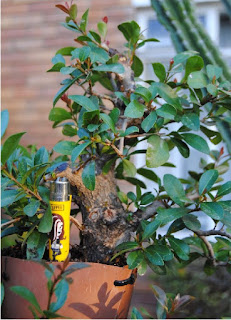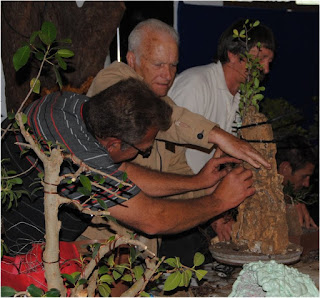I got this tree in the beginning of this year(about February 2012) as a
Lollypop tree. I did not care much for the trunk and crown because the
trunk was too straight. I liked it because the tree had a very nice
base. When I inspected the crown I did found a trunkline and decided to
go for a literati but I realized the tree was going to look a lot like
my one of my Privets. I decided to air layer the tree not to waste the crown. I
used the pot method with normal soil. I also removed branches to form
the trunkline.
The air layer done in Autumn(March/April, I think.):
A close up with a lighter as size comparison:
To force the layer to form roots quickly pieces of bark were removed on a regular basis. By October I removed the last piece of bark and the tree did not wilt. I
removed the layer by using a saw. The tree did not wilt after removing
it. Here you can see the screws I screwed into the trunk just below the lower cut to keep the pot upright. There was a hole cut into the bottom of the pot and the one side slit so the pot can be wrapped around the trunk. It was fastened with cable ties to keep everything together.
This is the biggest advantage of using the pot method. After removal the air layered part can be kept in the pot without any disturbance. Normal soil can be used so you dont get that entangled roots as with sphagnum.
The tree removed from the pot- nice roots has formed:
Potted up into a plastic training pot:
Cleaned up and wired:
The whole process took me only seven months - can't wait to start working on the bottom trunk!
I almost lost the tree after an overfeeding and poisoning the tree. I
struggled for weeks to keep the tree green because I knew I had lost
most of the root system. As a last resort I enclosed the pot with
aluminum foil to prevent any water loss and to keep out water also from
the soil. The foil was also to keep the tree in the pot because I
turned the tree upside down and submersed the area of the tree above the
soil level for 30 minutes every second day. Don't know if it helped but
the tree seemed to respond well to this treatment. The tree beginning
January after the treatment:
From there the tree has recovered well and it seems I have pulled it through. The tree today(March 2013):
I am going to let it grow wild so that it can grow a strong root system.
Very glad it did survive!
February 2014:
The tree has recovered well and I have planted it in a little bigger pot:
After removing some unwanted growth and wires:
Slightly from above:
I have not yet decided on the final placement of the branches. I will let it grow freely for another two weeks before I cut back the twigs.
Will update then.






















































